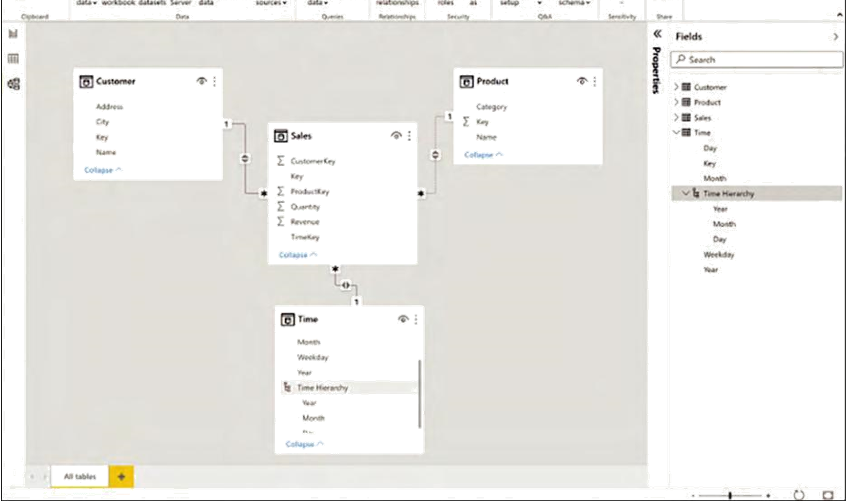Describe features of data models in Power BI
When you work with Power BI, you’re not just interacting with visual representations of data; you’re engaging with a meticulously structured data model. The depth and breadth of this model dictate the stories you can extract from your data. This section is a more detailed guide to the intricate features of data models in Power BI and how they set the stage for data-driven narratives.
Relationships
At the heart of your data model are relationships. They let you connect different tables for richer, multidimensional analysis. Think of relationships as bridging islands of data so they can talk to each other. For instance, as shown in Figure 4-22, you can link a Sales table to a Products table to reveal insights about which products drive the most revenue.
Skill 4.3 Describe data visualization in Microsoft Power BI CHAPTER 4 129

FIGURE 4-22 Power BI table (entity) relationship
BASICS OF TABLE RELATIONSHIPS
In the world of data modeling, especially within tools like Power BI, understanding the basics of table relationships is akin to learning the grammar of a language. These relationships are fundamental to how you interpret and interact with your data. Central to these relationships are concepts like keys and their types, the nature of the connections between tables, and the impact of these connections on data filtering and analysis. Here’s a closer look at these founda-tional elements:
■■ Primary and foreign keys: At the heart of any table relationship is the concept of keys.A primary key is a unique identifier for a record in a table. In contrast, a foreign key in one table points to the primary key in another table, establishing a link between them. It’s this connection that facilitates data retrieval across multiple tables.
■■ One-to-many and many-to-one relationships: These are the most common types of relationships you’ll encounter. In a one-to-many relationship, a single record in the first table can relate to multiple records in the second table, but not vice versa. Conversely, in many-to-one relationships, multiple records from the first table correspond to a single record in the second table.
■■ Many-to-many relationships: Occasionally, you might find that multiple records in one table relate to multiple records in another table. This complex relationship type,
130 CHAPTER 4 Describe an analytics workload on Azure
known as many-to-many, was historically handled using bridge tables, but Power BI now offers native support, simplifying its implementation.
■■ Cross-filtering and direction: Relationships in Power BI have a direction, dictating how filters are applied across related tables. This directionality ensures that when you apply a filter to one table, related tables are automatically filtered, preserving data context and integrity.